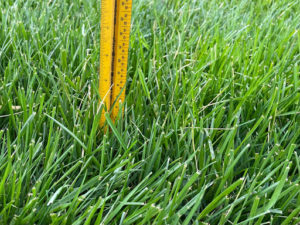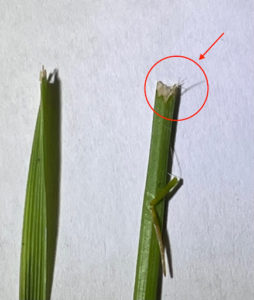Doing Your Part
With the approach of spring comes the beginning of lawn mowing season! One of the most crucial aspects of lawn health is proper and regular mowing throughout the year. The way a lawn is cut and trimmed is something that a homeowner can control; whether you prefer to do-it-yourself or hire a service. Please take a look at the recommendations and explanations listed in this article and consider making them a part of your regular lawn mowing routine. If you work with one of our partner mowing companies they are implementing these practices already!
Mowing Height
First and foremost in the hierarchy of important mowing practices is the height of the cut. Turf type tall fescue grass, found in all lawns in Ohio and most in Northern Kentucky, has an ideal cut height of 4 inches. That is 4 inches from the base of the grass bade to the tip. Fescue prefers a 4 inch or higher cut because the blade itself is designed to shade the roots of the grass from direct sunlight. When cut too short it is unable to do this. A clear indicator of a lawn that has been mowed too low is a pale green or “yellow-ish” color to the lawn right after mowing. Lawns cut too short are also more susceptible to weed breakout, turf density issues and summer burnout. An ideal mowing height will keep the lawn looking thick and a deep shade of green throughout spring, summer and fall.
Frequency
Lawn mowing frequency is almost equally as important as the cut height. Once spring growth begins, a tall fescue lawn should be mowed at least once every 7 days. With healthy soil and a regular feeding program mowing may even need to be increased to twice a week during weeks of plentiful sun and spring air. Waiting too long to mow creates two major problems. The first is, when you wait too long and the lawn has excessive growth there will be clumps of cut-grass left on the lawn after mowing. The clumps sit in the lawn and end up creating dead patches and leaving behind a mess. Secondly, waiting too long to mow and subsequently cutting too much off of the top of the grass causes stress to the grass and makes your lawn more susceptible to diseases. As a general rule, regular weekly mowing at a 4 inch height is the best practice for success.

Equipment
One of the other and less talked about factors for lawn mowing success is the type of mower used and its condition. The most important part of mower maintenance from a lawn health perspective is the sharpness of blade and angle of cut. A dull blade or improper cut angle will often tear the top of the grass blade off instead of cutting it. A mower that is under powered or cutting off too much grass at once may also tear the grass blade. The best way to avoid this issue is to maintain sharp blades, not wait too long between mowings and take half passes instead of full passes when the mower is bogging down. Cutting on a very high setting will also help keep the mower from struggling and yield better results. Tearing grass blades makes the grass more susceptible to disease pressure and often leaves the lawn looking “white” since the torn areas heal with a white tinge on top of the blade. Keeping your lawn mower blades sharp, mowing on a regular basis and keeping the cut height nice and high will give your lawn the very best opportunity to culturally control weeds and resist disease.

The Big Picture
Following a regular mowing schedule, cutting at the right height and keeping your blades sharp are the three best ways to keep your lawn healthy in conjunction with a feeding and weed control program. By putting these recommendations into practice you are helping your lawn culturally control weeds and making sure you get the most out of every lawn treatment. If you have any questions or concerns about the way your lawn looks please reach out to us at any time via phone call or email below.
Happy mowing!
Joseph Sheard
TurfGrass Experts
(513) 265-6703
Joseph.Sheard@TurfGrassExperts.com
TurfGrassExperts.com
